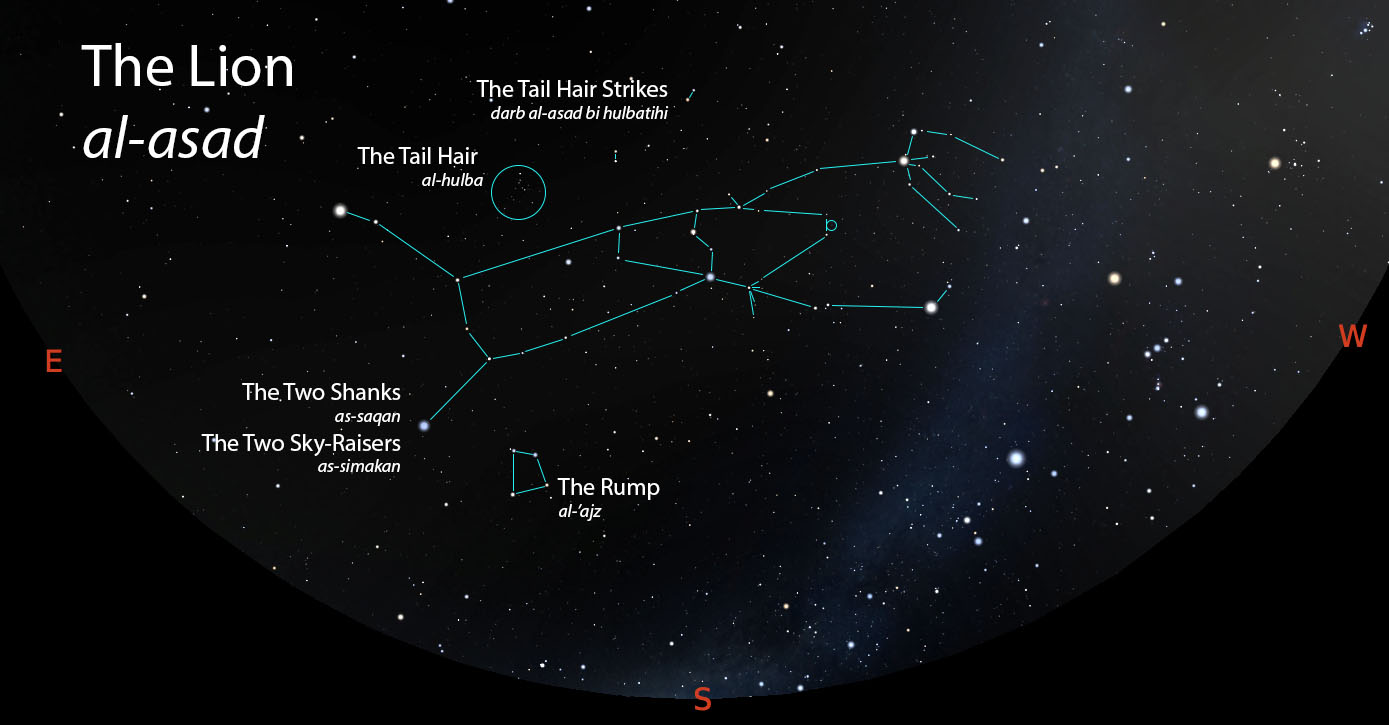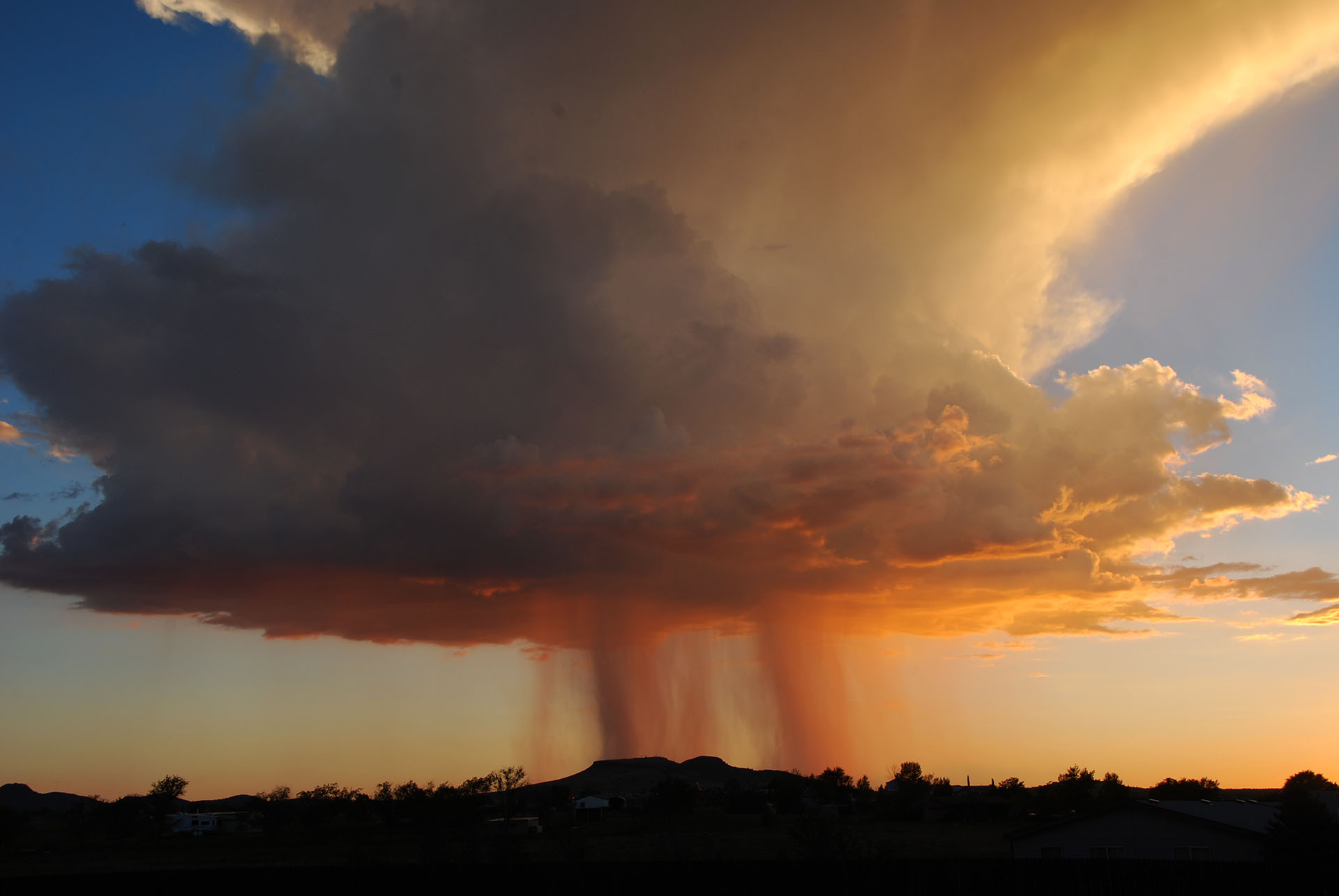Feature image by NOAA Photo Library CC BY 2.0, via Wikimedia Commons
Summertime in ancient Arabia began with rain, and that rain was marked by the pre-dawn setting of a remarkable pair of bright stars, the Two Sky-Raisers (as-simakan). In ancient Arabic, the term simak indicated something that was used to raise something else high up. The related term samk indicates the thing that was raised, like a ceiling or roof. When the Two Sky-Raisers reached the midpoint of their travels across the night sky, the uppermost one was almost at the zenith, right over your head, and the lower Sky-Raiser was almost directly below it, about halfway up the sky. The Two Sky-Raisers were the pillars that held up the canopy of the heavens. When they set, they defined the period of summertime rains(as-sayf).
جدا قضة الآساد وارتجست له بنوء السماكين الغيوث الروائح
…with good fortune at the dawn setting of the Lions,
and by means of the rain period of the Two Sky-Raisers
the widespread afternoon rains thundered vehemently upon him.Dhu ar-Rumma
735 C.E.
The Two Sky-Raisers also completed the picture of the Lion, as each one of the pair was regarded as a Shank of the Lion (saq al-asad).
How to observe the Lion and its Sky-Raisers
When the whole Lion was above the horizon, it nearly covered the sky from west to east as it consumed some 135 angular degrees of the sky. In order to present this entire figure, the locator map below has a much larger scale than usual.

Wide-field view of the Lion (al-asad) and its elements as they appear when its Forehead (al-jabha) is in the middle of the sky. Sky simulations made with Stellarium.
The proper time to observe a star’s morning setting (or rising) is called ghalas in Arabic, at time when the darkness of night mixes with the white and red light of dawn in the tracts of the horizon (How to Observe). Look to the western horizon about 45 minutes before your local sunrise (times available at timeanddate.com).
The Two Sky-Raisers as rain stars
For a brief description of the rain stars, please see the Celestial Complexes section on the About page.

The Two Sky-Raisers (as-simakan) as they appear setting in the west about 45 minutes before sunrise in late April.
In the calendar of Qushayr, the Two Sky-Raisers defined the beginning and end of the short rainy season of summer (as-sayf). These two bright stars set about 40 days apart, and whatever was between their settings was summer. The rain that fell during this period was plentiful and was said to connect the lands that had not yet been rained on to the rained-on lands that lay among them.
The first one to set was the Unarmed Sky-Raiser (as-simak al-a’zal), so named because it is was separated from the other stars. The last of the pair to set was the Spear-Bearing Sky-Raiser (as-simak ar-ramih). It got this name from the star that lies in front of it, which was said to be its Spear (ar-rumh). The calendar of Qushayr refers to this second Sky-Raiser as the Watcher (al-raqib), a name that comes from its high position above the Unarmed Sky-Raiser when they are both high in the sky and when they are setting.
The Unarmed Sky-Raiser and the Concealment as lunar stations
For a brief description of the lunar stations, please see the Celestial Complexes section on the About page.
The Sky-Raisers demonstrate very well the difference between a rain star asterism and a lunar station. We just saw that in the calendar of rain stars, these two bright stars defined the start and end of the summer rainy season. In the calendar of lunar stations, however, only one of them was qualified to be a lunar station, the Unarmed Sky-Raiser. This is because the Moon’s path took it right by this star. The Spear-Bearing Sky-Raiser, on the other hand, is located much further north in the sky, so the moon never stations next to it. The Unarmed Sky-Raiser was the 14th lunar station.
Sometimes when the Moon deviated to the south of its usual route through the sky, it stationed near a group of four stars located below the Unarmed Sky Raiser and called the Throne of the Sky-Raiser (‘arsh as-simak). Within the celestial complex of the Lion, this star grouping was called the Rump of the Lion (‘ajuz al-asad). (See the Lion’s star map, above.)
The 15th lunar station was the Concealment (al-ghafr), a trio of faint stars that follow in the path of the Unarmed Sky-Raiser. Its name comes from the verb ghafara, which means “to conceal, cover or hide”, so it plainly describes the faintness of this lunar station. Another possible meaning for this word is the downy hair that appears on the back of a person’s neck, as well as other places on the body, so named because it is not easy to see.
The Persian scholar al-Biruni (d. 1048 CE) reported that the Arabs saw this asterism to represent the neck armor (mighfar) of the Scorpion (al-‘aqrab), which is the next celestial complex that we’ll encounter. Al-Biruni’s contemporary, az-Zajaj, said that these stars represented the hair at the tip of the Lion’s tail. Neither of these interpretations of al-ghafr is consistent with the known Arab depictions of the Lion or the Scorpion, so they were most likely later embellishments. However, they both hint at a saying recorded by Ibn Qutayba (d. 889 CE) much earlier:
الغفر خير منزلة في الأبد
بين الزبانى وبين الأسد
The Concealment is the most fortunate lunar station for time without end,
between the Claws of the Scorpion and the Lion.Arab saying
The Concealment was called “the most fortunate lunar station for time without end, between the Scorpion and the Lion” because it lies between the hind legs of the Lion and the claws of the Scorpion, and yet it is never harmed. For the rest of time, this lunar station is concealed from those two formidable beasts.
A harvest of Babylonian corn
In this region of sky, the Arabian tradition of the Two Sky-Raisers dominated that of the Lion, whose Shanks never made it into the poetry like the Two Sky-Raisers did. Nothing of the Lion remains in this region of the modern sky. As for the Two Sky-Raisers, their influence did pass to European astronomy, for a time. The star that is today called Spica (α VIR) was in European medieval times called Azimech, which has an obvious sound correlation to as-simak. During the European Renaissance, with its focus on classical Greek sciences, the name Spica was discovered to have been applied to this star by the Greeks, Romans and Babylonians, and so it was reapplied by the Europeans. The name indicates an ear of corn and was prominent among Babylonians during the first millenium BCE. Ibn Qutayba commented that the mathematicians of his day (who studied Greek astronomy) used the Arabic translation of this term, as-sunbula, to refer to Spica, but the Arabs still referred to it as the Shank of the Lion (saq al-asad). The Arabs did have an asterism called the Ear of Corn (as-sunbula), but it was the large star cluster that also represented the Tail Hair of the Lion (hulbat al-asad).
What’s next?
In the next post, we experience the first drought in our rain star calendar as a giant Scorpion dominates the sky.
In the meantime, I’d love to hear from you! Please leave a comment below, and tell me about your observations of these ancient asterisms. Be sure to include your city and state/country so we can see how the timings vary by location.
Star Catalog Entries for this Celestial Complex
The Lion Celestial Complex (al-asad, الأسد)
The Two Shanks (al-saqan, الساقان)
The Rump of the Lion (‘ajz al-asad, عجز الأسد)
The Tail Hair (al-hulba, الهلبة)
The Tail Hair Strikes (darb al-asad bi hulbatihi, ضرب الأسد بهلبته)
The Sky-Raisers Celestial Complex (as-simakan, السماكان)
The Two Sky-Raisers (as-simakan, السماكان)
The Unarmed Sky-Raiser (as-simak al-a’zal, السماك الأعزل)
The Spear-Bearing Sky-Raiser (as-simak ar-ramih, السماك الرامح)
The Spear (ar-rumh, الرمح)
The Throne of the Sky-Raiser (‘arsh as-simak, عرش السماك)
The Concealment (al-ghafr, الغفر)
Click here to go to the full star catalog (a work in progress).


